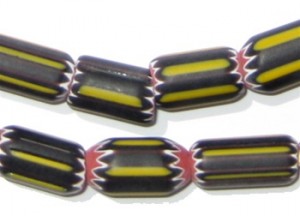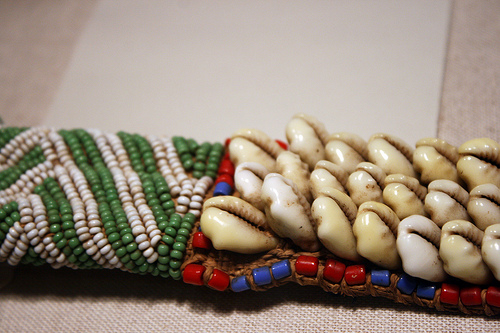The Fascinating History of Cowrie Shell Beads as Legal Tender in Africa
The humble cowrie shell has many connotations and uses in African culture – not least as a form of legal tender up until the early 20th century. Symbolic of both destiny and prosperity, the shell of Cypraeidae molluscs (large sea snails) was considered particularly valuable by tribes in West Africa, whom associate them with various ocean deities associated with wealth and strength. Such was the value of the cowry to Ghanaian tribespeople, they even named their currency (the “cedi”) after these marine molluscs!
Interestingly, cowrie shells are not native to Africa. They are predominantly found in the Indian and South Pacific Oceans, most notably around the Maldives and Fiji. According to historians, it's likely that strands of these small, polished 'sea eggs' were introduced to Africa by Chinese merchants sometime around the 9th century, making them one of the earliest types of trade beads to be used as a medium of exchange anywhere in Africa.
The value of the cowrie shell is well documented to have been far greater in West Africa than elsewhere on the continent, and many attribute this to the West Africans' love of beads for self-adornment. Merchant journals from the 19th century suggest that gains for cowrie shells sometimes exceeded 300%! The lucrative trade in cowrie shells during the 1800s led to the development of a recognised currency system of sorts, with around 20-30 strings equating to one dollar. Inland too, the measure of one's wealth was counted in cowrie shells; the then king of Bornu estimated to be worth more than 30,000,000!
Today, the cowrie shell continues to play a central role in the cultures and faiths of many African tribes. Some tribes, such as the Maasai, hang cowrie shells from the bride's wedding necklace to encourage fertility and prosperity, while in rural parts of Ghana, whole strands of shells are gifted to the groom as part of the bride's dowry. But value aside, cowrie shells are a beautiful natural element for tribal inspired jewelry, and in contrast to the 19th century, aren't all that expensive either!
Shop Cowrie Shell Beads - 80 Shells per Strand
Art Seymour: The Man Reviving Chevron Bead Art in Ghana
Art Seymour, the pioneering mind behind the Share The Magic project currently in operation within Odumase Krobo, Ghana, attributes his "passion for glass" to a very early childhood memory. As an impressionable 5 year old, Art enjoyed nothing more than visiting his grandmother's house, particularly due to the fascinating array of curios she had accumulated through her lifetime. One of these would instill an obsession, that later became his sole purpose for breathing. That object was a paper-weight. One of the prism-like desk variety, that most will have at one point or another seen in antique, thrift or charity stores gathering dust.
Fascinated by the intense colours, light refraction and almost "edible" richness created by the colored glass, Art would later find his childhood memory becoming sole inspiration for reviving a long-considered dead art-form - Chevron bead-making.
For those unfamiliar with Chevron beads; they are a product of the merchant trade era, originally produced within Venice, and transported to Africa by merchants plying trade en route to bigger destinations such as the Americas. A type of African trade beads, they are created using the 'cane technique', that is, the adhering of several long glass canes in a step-by-step manner, to create star and stripe beads of magnificent colorings. Such beads became a treasure for the people of Ghana, during a period when Venetian trade beads were regarded as more than just pretty jewelry objects - they were currency!
Art Seymour commenced a revival of Chevron bead-making from his own workshop in Nevada. Already producing Murano-like pieces for ornamental purposes, his expertise led to the experimentation with the cane technique. As word of his expertise spread, so too did interest in his wares for retail, prompting yet another inspiration. Taking Chevron bead creation, back to the country who still regard these beads as treasure. That country was Ghana, and so, the Share The Magic Project was born.
Partnering with an extremely well known Ghanaian bead 'master' known as

Yellow Jacket Striped Chevron Beads
Nomoda E. Djaba (Cedi bead factory), Art Seymour set about refining a bead production process in 2008, that would utilize the present powder glass bead-making methods currently used in Ghana. The process created brand new molds, setting and cooling techniques through trial and error with two engineering associates on-hand for scientific purposes. This refinement then saw the first of two phases completed, as the lab was packed up and taken to Ghana.
The second phase of Share The Magic Project in March 2008 was funded by the sale of Seymour's bead creations (many limited edition.) The trip was focused upon the building of a "hot glass facility" and education center at Odumase Krobo, that would allow the teaching of Seymour's learned techniques. So the 'Hands Across The Water' phase of Share The Magic was rolled out, and is still in operation today, teaching and providing Ghanaian citizens with the skills to produce stunning multi-colored Chevrons, that are now again, as collectible and prized as they were in the 19th Century!
